


Periodic Table Evolution: Predicting Element Properties and Trends is a dynamic teaching resource designed to help educators explain the historical development and practical applications of the Periodic Table. This resource offers comprehensive tools and materials to guide students through understanding how the Periodic Table has evolved over time and how it can be used to predict the properties of elements. Educators can use this resource to illustrate the development of the Periodic Table, hig
8 th - 10 th Chemistry , Science Also included in: Chemistry Year Long Lessons | Bundle | Printable $10.00 Original Price $10.00 Add to Cart

Each double-sided page can be printed and used throughout a week with exercises based on one element , the element spotlight. Scaffolded with reminders of how to read the periodic table, and is suitable as soon as you've introduced atoms! We all need spiral review some times. Want a preview? Download "Helium" for a sample. This bundle includes elements 1-10. Want more? Check out the "Warmups" tag in my store for more elements. Skills Practiced - Reading the periodic table (APE-MAN) Groups
8 th - 12 th Chemistry , Physical Science Show 10 included products $9.00 Original Price $9.00 Add to Cart

Background: When the elements are arranged in order of increasing atomic number, they exhibit a periodic recurrence of properties . Elements in the same group in the periodic table tend to have similar physical and chemical properties . These similarities are due, in large part, to similarities among the electron configurations of the elements in a group. You can find periodic trends in certain properties , such as density, among the elements within a given group. In this experiment, you will:
11 th - 12 th Original Price $3.00 Add to Cart

Students have just discovered a new element to be added to the Periodic Table. They must name the element appropriately, come up with a new symbol, predict the atomic number and mass, along with what properties and ion the element will form.
9 th - 12 th Chemistry , General Science , Physical Science Add to Cart
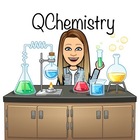
Guided notes that provide a concise explanation of the main topics in high school chemistry. Animated Google Slides that follow along are also available. Topic numbers left off for you to customize. Google slides presentations contain animations with the answers filled in as well as any problems completely worked out for the guided notes. Goal: 6.8 Determine the intermolecular forces for a molecular compound. Other Goals in this unit:6.1 Predict the type of bonding present between two atoms in
10 th - 12 th Chemistry , Science Also included in: Unit 6 Bonding All in one: Guided Notes, Presentation & Learning Activities Original Price $1.00 Add to Cart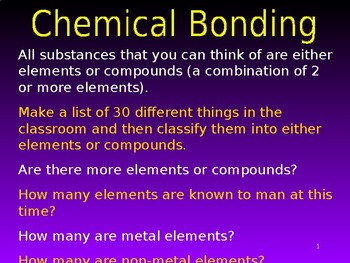

Elements & compounds, intermolecular bonds in compounds, covalent, ionic & metallic bonds, Lewis & Couper structures, stable octet structures, energy vs distance graph when simple molecule is formed, making NaCl, it's crystal lattice, predicting which type of bond is formed when molecules are formed, properties of metals. Excellent for classroom teaching with a data projector and for use on a mobile.
9 th - 11 th , Not Grade Specific Chemistry , General Science , Physical Science Also included in: Grade 10 Atomic structure, periodic table and chemical bonding in PowerPoint. Original Price $3.00 Add to Cart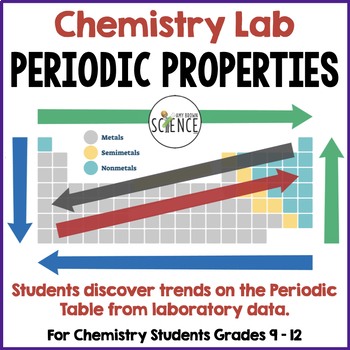
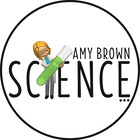
This chemistry lab, Periodic Properties and Trends on the Period Table, provides a hands-on and visual lab activity showing the trends and relationships that exist among the elements in a Group or family. In this experiment, students will observe the periodicity of the properties of density and solubility of compounds within groups. Includes editable student handouts.What will the students be doing?Students calculate the density of certain metals to determine the trend in density seen in the G
9 th - 12 th Chemistry , Other (Science) , Science CCSS , NGSS Original Price $3.00 Rated 4.94 out of 5, based on 31 reviews Add to Cart

HS-PS1-1: Using the Periodic Table to Predict Element PropertiesThis resource provides an in-depth exploration of the periodic table, helping students understand the structure, trends, and properties of elements. The material covers: Atomic Structure: Descriptions of protons, neutrons, and electrons, along with explanations of atomic number, mass number, and electron configuration.Periodic Table Layout: Students will learn how periods and groups organize elements and how these arrangements predi
9 th - 12 th Chemistry , Physical Science , Science CCSS , NGSS Original Price $10.00 Add to Cart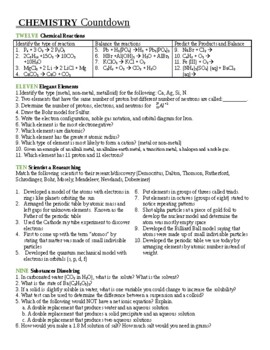
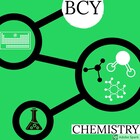
TOPICS INCLUDED: 12 Chemical Reactions (Identify, Balance and Predict Product) 11 Elegant Elements (Identify subatomic particles and properties using the periodic table--includes trends and electron configuration) 10 Scientist a Researching (Atomic Theory and Periodic Table Scientist) 9 Substances Dissolving (Solution Chemistry Practice including vocabulary, solubility, and molarity) 8 Compounds Calculating (molar mass, percent composition, hydrate, mole conversions) 7 Salty Solutes (using a so
10 th - 12 th Chemistry , General Science , Science Original Price $5.00 Add to Cart

In this unit, the atomic radius of an element is examined and studied how the atomic radius can influence the physical and chemical properties of the elements. The unit starts out with an at-home activity so the student can wrap his head around the radius of a circle/sphere and the volume of the sphere. An element 's reactivity is largely explained and predicted by its location on the periodic table and its effective nuclear charge. The student will learn how to predict the overall trends of ato
9 th - 12 th Chemistry , General Science , Physical Science CCSS , NGSS Original Price $19.99 Add to Cart

In this practice packet, students will: 1) Use the Periodic Table to predict if elements will gain or lose electrons to become anions or cations. 2) Model ions using Bohr Models 3) Model Ionic Bonds using Lewis Dot Models 4) Find properties of ionic substances and create a concept web
7 th - 11 th Original Price $1.00 Add to Cart

This PowerPoint address the concept of ionization energy as it relates to atomic properties such as atomic radius and nuclear charge. Students learn to predict the ionization energies of elements qualitatively based on their placements on the periodic table. Most of my chemistry lessons are 8 slide PowerPoints. I print the PowerPoints each day (4 slides per page. front and back = 1 sheet of paper per student). The students then fill out the answers to my guided and scaffolded questions as I f
10 th - 11 th Original Price $5.00 Add to Cart

Aligned with NGSS: HS-PS1-1 Use the periodic table as a model to predict the relative properties of elements based on the patterns of electrons in the outermost energy level of atoms.This simulation guides students with questions related to how covalent bonds form, what happens to the electrons within covalent bonds, different types of covalent bonds, and how to write the names of covalent compounds. This simulation is great for independent exploration, guided practice, blended learning, and
7 th - 10 th Chemistry , General Science , Science Original Price $2.00 Add to Cart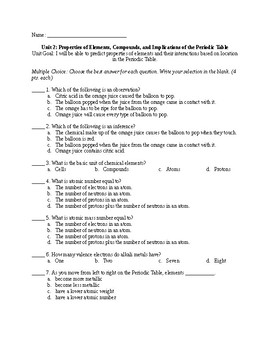

Unit: Properties of Elements , Compounds, and Implications of the Periodic Table Unit Goal: SWBAT predict properties of elements and their interactions based on location in the Periodic Table. Unit Puzzling Phenomenon: Orange peel popping balloon NGSS Performance Expectations Addressed: MS-PS1-1 Develop models to describe the atomic composition of simple molecules and extended structures. This test includes multiple choice, matching, short answer, and long answer questions. The questions ar
6 th - 9 th Chemistry , Physical Science , Science Original Price $2.00 Add to Cart

24 Game Cards - Elemental CompositionIn this set of game cards, the students will predict elemental composition. Standard coveredSPS2. Obtain, evaluate, and communicate information to explain how atoms bond to form stable compounds. a. Analyze and interpret data to predict properties of ionic and covalent compounds. ( Clarification statement: Properties are limited to types of bonds formed, elemental composition, melting point, boiling point, and conductivity.) ObjectivesStudents will be ab
8 th - 12 th Chemistry , Physical Science , Physics Original Price $4.99 Add to Cart

This study guide assess all Unit 6 topics. Goals in this unit:6.1 Predict the type of bonding present between two atoms in a binary compound based on position in the periodic table and the electronegativity of the elements 6.2 Describe the formation of an ionic compound. 6.3. Recognize properties of ionic compounds. 6.4 Explain how metallic bonds result in the macroscopic properties of metals (e.g., conductivity, malleability, ductility, and low volatility). 6.5 Illustrate covalently bonded
10 th - 12 th Chemistry , Science Original Price $1.50 Add to Cart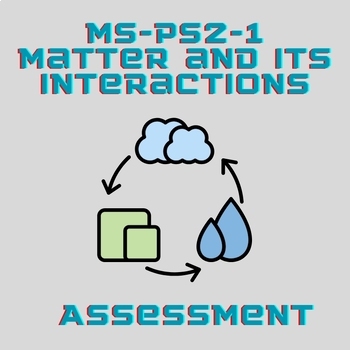
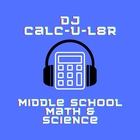
Matter and Its Interactions Standards AddressedMS-PS1-2Analyze and interpret data on the properties of substances before and after the substances interact to determine if a chemical reaction has occurred.MS-PS1-3Gather and make sense of information to describe that synthetic materials come from natural resources and impact society.MS-PS1-4Develop a model that predicts and describes changes in particle motion, temperature, and state of a pure substance when thermal energy is added or removed.Stud
7 th - 9 th General Science , Physical Science , Science CCSS , NGSS Add to Cart

Jeopardy – Predict Properties Review Game – 25 Google Slides (Distance Learning)In this game the students will predict properties of elements . These are the same questions and answers used in the review game, “ 24 Predict the properties and locations Game Cards – Analyze/Interpret Trends.” Standard coveredSPS1. Obtain, evaluate, and communicate information from the Periodic Table to explain the relative properties of elements based on patterns of atomic structure. c. Use the Periodic Table as
8 th - 12 th Chemistry , Physical Science , Physics Original Price $4.99 Add to Cart

A revision homework or class worksheet with answers that covers Noble Gases (Group 0 / Group 8 Elements ) in C1 Chemistry. Save over 75% with the TES Bundle. Including a variety of questions, filling in gaps, predicting chemical properties and interpreting a table. What’s inside?1 Revision/worksheet with a variety of different questions 1 Answer sheet Which content does it cover?This practice sheet covers part of Topic 1 of Chemistry - Atomic Structure and the Periodic Table. It’s designed for
9 th - 10 th Original Price $1.69 Add to Cart

HS-PS1-1 Properties of elements Full Lesson ppt •Use the periodic table as a model to predict the relative properties of elements based on the patterns of electrons in the outermost energy level of atoms.
8 th - 12 th Original Price $10.00 Add to Cart

Practice problems on goal 6.6- 6.8. Also included in:Unit 6 Bonding Learning Activities & Test BundleUnits 1-14 Chemistry Learning Activities, Labs & Assessments BundleFull Year Chemistry Guided Notes, Presentations & Learning Activities BundleGoals in this unit:6.1 Predict the type of bonding present between two atoms in a binary compound based on position in the periodic table and the electronegativity of the elements 6.2 Describe the formation of an ionic compound. 6.3. Recognize properties
10 th - 12 th Chemistry , Science Original Price $1.00 Add to Cart

The lesson explores the significance of the periodic table as a foundational tool in chemistry, elucidating its role in organizing elements , predicting their properties , and fostering interdisciplinary connections.Student Focus:Understand the purpose and significance of the periodic table in organizing elements .Identify the key components of the periodic table, including chemical symbols and atomic numbers.Differentiate between metals, nonmetals, and metalloids based on their properties and loca